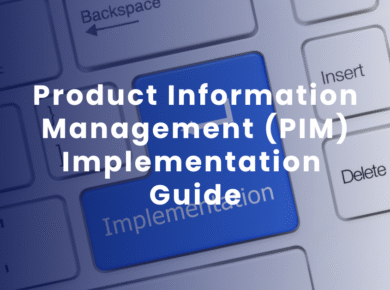How Will GenAI Redefine the Hybrid Shopper Experience? Read Blog Holiday shopping
Managing product data effectively has become a growing challenge for businesses navigating complex product catalogs, expanding into new markets, and meeting increasing customer demands. If you’re relying on outdated PIM systems or manual processes, it may be time to consider migrating to a more powerful and modern Product Information Management (PIM) solution.
But PIM migration isn’t just about changing tools — it’s about transforming how your business handles product information across every channel.
What Is PIM Migration?
PIM Migration is the process of transferring your existing product data — from legacy PIM platform to a modern PIM system. But it’s more than a data transfer. It’s about restructuring, optimizing, and preparing your data for better accuracy, efficiency, and future growth.
A robust PIM system, especially one that is AI-enabled, acts as your single source of truth, enabling you to store, manage, and distribute product information seamlessly across ecommerce platforms, marketplaces, and internal systems.
Why Do Business Migrate to a New PIM?
Most migration journeys begin when existing systems simply can’t keep up. Here are some of the most common reasons businesses decide to make the move:
Growing Product Complexity: As product attributes multiply — whether due to regulatory changes, customer personalization, or new channel requirements — traditional tools like spreadsheets or basic ERP add-ons start to fall short.
International Expansion: Entering new markets means managing multiple languages, currencies, and region-specific content. Without a centralized PIM, this process becomes time-consuming and error-prone.
Lack of Scalability: When you’re dealing with thousands of SKUs or intricate product hierarchies, fragmented data tools quickly become bottlenecks.
Improved Data Quality: Migrating to a modern PIM system gives businesses the chance to cleanse, standardize, and enrich product data for better accuracy.
Operational Efficiency: A well-structured PIM eliminates repetitive manual work and reduces errors across departments.
Enhanced Customer Experience: When your product content is consistent and complete across all touchpoints, customers benefit from clearer, more trustworthy information.
Faster Time to Market: With streamlined processes and automation, new products can be launched across multiple channels more quickly — especially with the help of AI-enabled PIM capabilities.
Key Components of PIM Migration
Migrating to a modern or AI-enabled PIM system isn’t a plug-and-play task — it requires a structured approach. Here’s what a typical PIM migration involves:
1. Planning and Strategy: Every successful migration starts with a clear plan. This includes identifying what data needs to be moved, how it should be structured in the new system, and what success looks like.
2. Data Mapping: Understanding how data fields relate between the old and new systems is critical. This ensures that all product information — from basic details to enriched content — is correctly aligned.
3. Data Cleansing: Before migration, data must be reviewed for accuracy and consistency. This includes removing duplicates, fixing formatting issues, and resolving inconsistencies in categories, attributes, and values.
4. Data Loading: Once the data is clean and mapped, it’s ready to be loaded into the modern PIM system. This step often includes batch imports, configuration of product hierarchies, and attribute setup.
5. Testing and Validation: Before going live, extensive testing is essential. This ensures that all migrated data appears as expected, and the new system functions correctly within your ecosystem.
6. Cutover: This is the transition from the legacy PIM system or other source to the new one. A well-managed cutover minimizes disruptions and ensures continuity in daily operations.
7. Training and Support: To maximize adoption, users need training on how to navigate and leverage the new system. Ongoing support ensures they can continue using it effectively — particularly when new AI-driven features are involved.
Also read: PIM and Magento Integration: How It Works?
What Makes a PIM Migration Successful?
A smooth migration is rarely just about installing new software. It’s a structured process that involves planning, collaboration, and clarity from the start.
Here’s what successful migrations have in common:
Defined Data Governance: Assign a dedicated team or at least a data steward to oversee the product information structure, quality, and workflows. Governance brings long-term consistency.
Stakeholder Involvement: Include representatives from marketing, IT, product, and operations. Their input ensures the new system meets real-world needs and increases adoption after go-live.
Clear Scope and Expectations: Map out what you need from your new PIM platform, what problems it should solve, and how it fits into your broader digital ecosystem. Avoid vague goals or assuming “it’ll work itself out.”
Common Challenges to Avoid
A smooth migration is rarely just about installing new software. It’s a structured process that involves planning, collaboration, and clarity from the start.
Here’s what successful migrations have in common:
Defined Data Governance: Assign a dedicated team or at least a data steward to oversee the product information structure, quality, and workflows. Governance brings long-term consistency.
Stakeholder Involvement: Include representatives from marketing, IT, product, and operations. Their input ensures the new system meets real-world needs and increases adoption after go-live.
Clear Scope and Expectations: Map out what you need from your new PIM system, what problems it should solve, and how it fits into your broader digital ecosystem. Avoid vague goals or assuming “it’ll work itself out.”
Why Expert Guidance Matters?
While the concept of PIM migration may seem straightforward, its execution often reveals hidden complexities — from incomplete data to misaligned processes and unforeseen integration challenges. That’s where expert support becomes invaluable.
At Innowinds, we specialize in PIM migration services that are both technically sound and strategically aligned with your business goals. Whether you’re moving from a legacy PIM system or upgrading to an AI-enabled PIM, our approach includes:
- End-to-end migration planning.
- Data mapping and cleansing frameworks.
- Seamless system integrations.
- Team training and post-migration support.
Whether you’re transitioning from spreadsheets or modernizing to a more intelligent, AI-enabled PIM solution, our team ensures that your product data works smarter — not harder.
Ready for a seamless and hassle-free PIM migration? Speak to our experts and start your journey today.
Latest Resources
How Unified Data Can Keep You Ahead This Holiday Read Blog As
Enterprise Data Management in Transition: 2026 Trends and AI-Driven Shifts Read Blog
Unlocking Growth: Why PIM DAM Integration Is a Strategic Imperative Read Blog
Mastering Product Data Syndication: A Business-Centric Approach Read Blog Why Accurate Product
The Hidden Costs of Missing Metadata in Digital Asset Management Read Blog
Key Takeaways: Identify the Right Time for PIM: Gain clarity on identifying
PIM vs MDM: What’s the Difference and When to Use Each? Read
Questions to Ask When Choosing a PIM Vendor? - Part 2 Read
Questions to Ask When Choosing a PIM Vendor? - Part 1 Read









